 Topics
Topics
 excel
excel
 Practical Excel skills sharing: 7 practical positioning skills to help you improve work efficiency
Practical Excel skills sharing: 7 practical positioning skills to help you improve work efficiency
Practical Excel skills sharing: 7 practical positioning skills to help you improve work efficiency
The positioning function in Excel is very powerful, but many newcomers in the workplace can only locate blank spaces. In fact, it also has many very useful functions. Today I will share with you 7 Excel positioning skills.

Tip 1: Quickly fill across rows
The following table is a table of department information for employees of a company. Now you need to fill in the blank cells in the department column Fill based on the top cell.
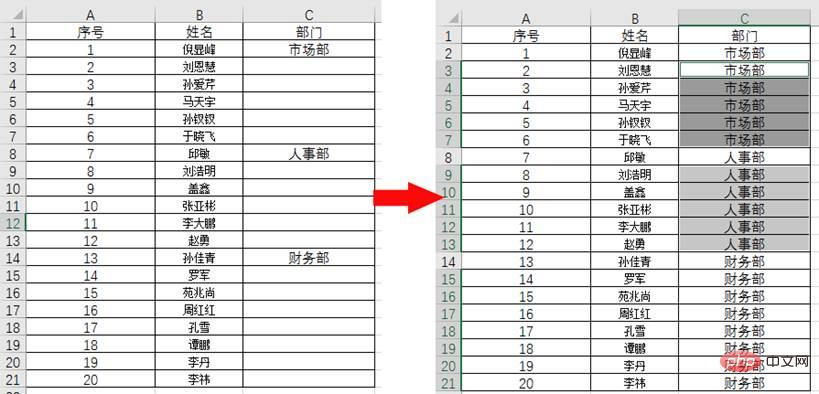
#In the above situation, if there is not much content, just drag the mouse to fill it in quickly. If there is a lot of content, our first priority would be to use Ctrl+G to locate the space and then quickly fill it in.
Operation steps:
(1) Select the C1:C21 data area and press the Ctrl G shortcut key, click [Positioning Conditions], and single-select the [Null Value] option.
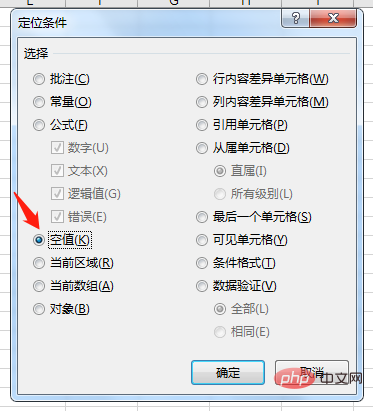
(2) Click [OK] and the blank cells in the C1:C21 area have been selected.

(3) Enter =C2 in the edit bar and press the shortcut key Ctrl Enter to fill all the blank cells.
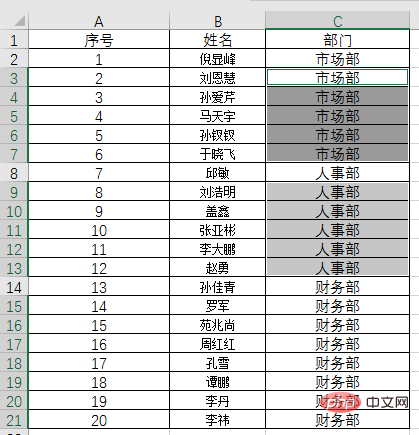
Tip 2: Quickly merge the same cells
This technique is suitable for situations where there is a lot of data, such as hundreds or thousands of rows of data. Merge identical cells in the same column.
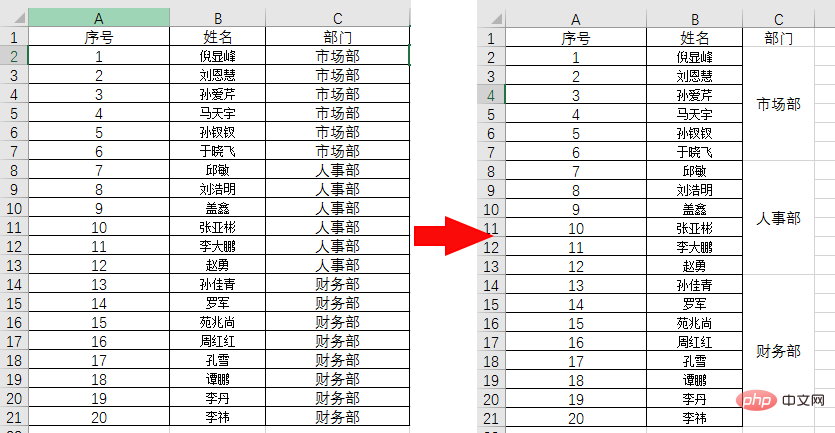
Operation steps:
(1) Use D as the auxiliary column, and enter the function =IF(C2=C1,D1,D1 in unit D2 1), the purpose is to label the same departments.
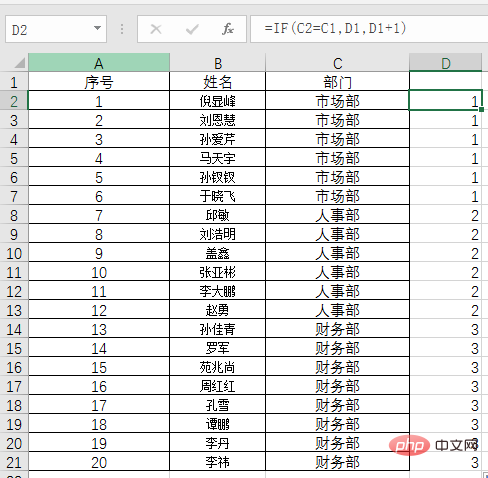
(2) With column E as the auxiliary column, enter the function formula =IF(-1^D2>0,"a",1) in cell E2. The meaning of the formula is that by calculating -1 raised to the 1st power is -1 and -1 raised to the 2nd power is 1, the results obtained are -1 and 1. Then use the IF function to distinguish it into numbers and text forms such as 1 and a.

# (3) Use the CTRL G shortcut key to open the [Location Conditions] dialog box.
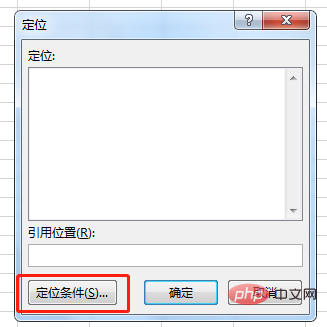
(4) In the [Positioning Conditions] dialog box, select [Number] in [Formula] and click OK.
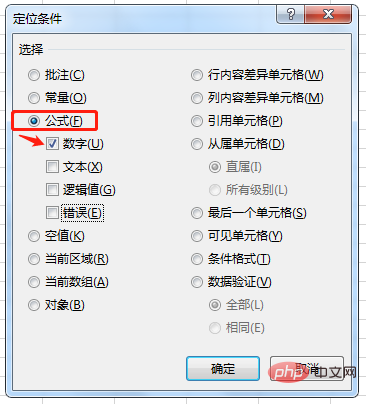
(5) Select the number in column E, and then click the [Merge and Center] function.
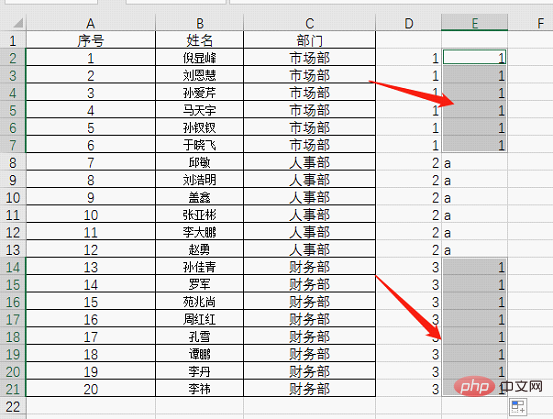
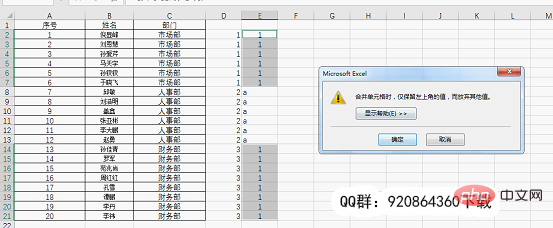
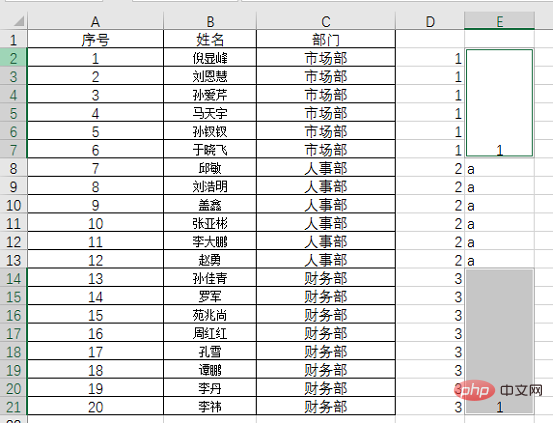
(6) Locate the text content in column E again, and do the same after selecting the cell Click the [Merge and Center] function.
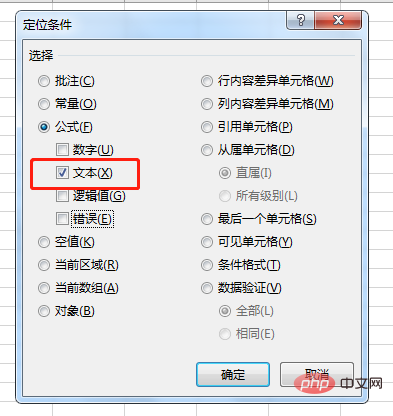
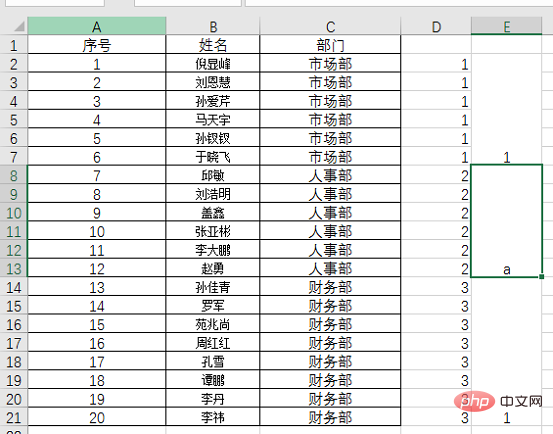
(7) After completing the merger of column E, select column E, click the format painter, and format the target cell in column C. Refresh.

In this way, we have completed the merging of the same cells. You can try to demonstrate the operation yourself.
Technique 3: Number Batch Color Marking
The following table is the employee assessment score information table. Now we need to mark all scores in red.
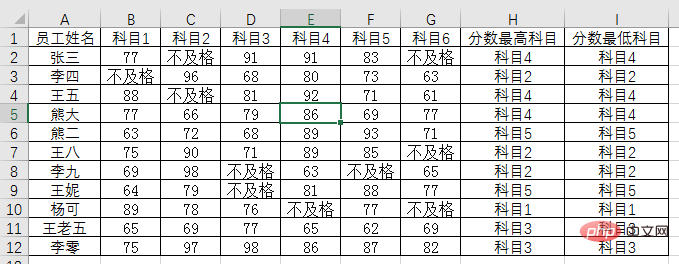
Operation steps:
(1) After selecting the entire table, use the CTRL G shortcut key to open the positioning dialog box, and click [Positioning Conditions].
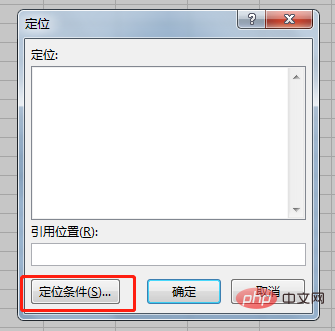
(3) Open the [Positioning Conditions] dialog box, click [Constant], we see that the check box below becomes selectable, check the number Selected.

Click [OK], and all the numbers in the table will be selected.
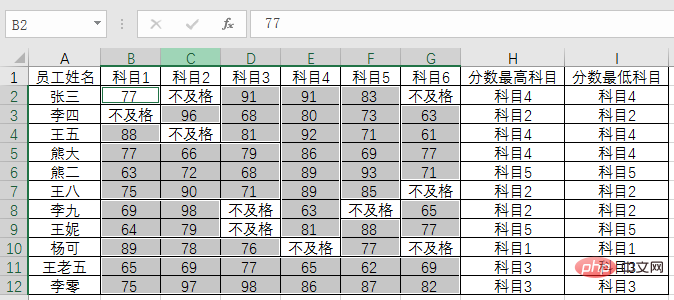
(4) Set the text color and complete the digital color marking.

Tip 4: Delete comments in batches
The following table is a detailed list of expenses for a certain property formula. There are comments in part of the data in the document amount, which are now needed Delete all comments.
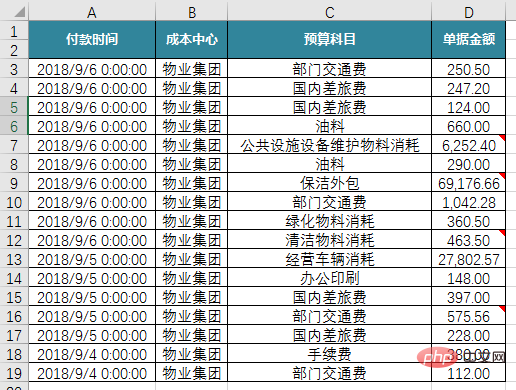
Operation steps:
(1) After selecting the entire table, use the CTRL G shortcut key to open the [Location Conditions] dialog box and select annotation.
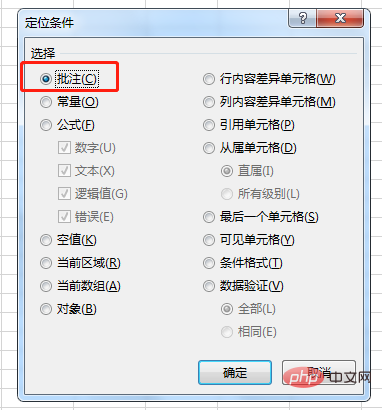
Click "OK" and we see three cells with comments selected.
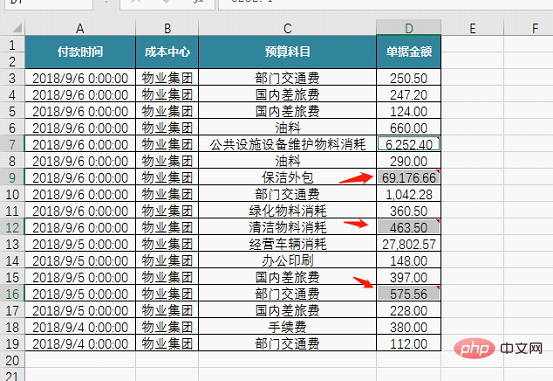
# (2) Right-click the mouse and select "Delete Comment" to complete.
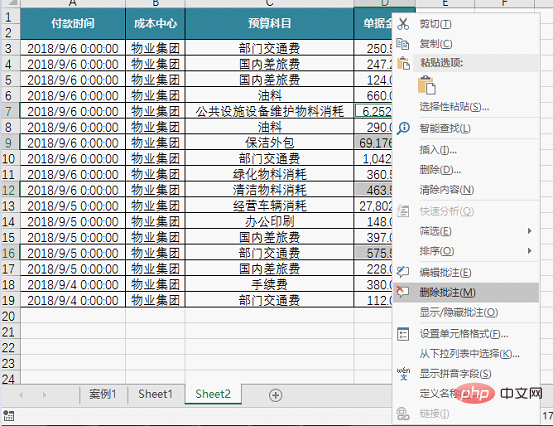
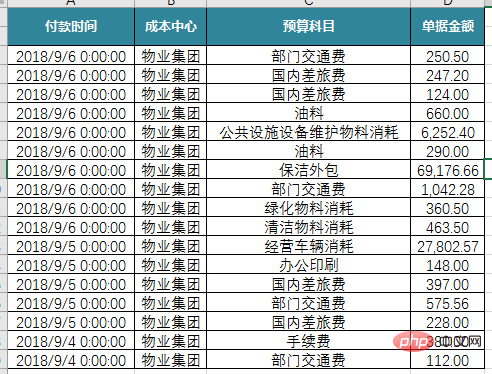
Tip 5: Quickly find the difference in row/column content
The positioning function can also quickly compare two rows ( The difference between the contents of multiple rows) or two columns (multiple columns). The teacher's answers and accounting reconciliations are very useful.
How to compare? One row (column) serves as the standard and the others serve as comparison rows (columns). The standard row (column) is the row (column) of the cell where the mouse first clicks when selecting data.

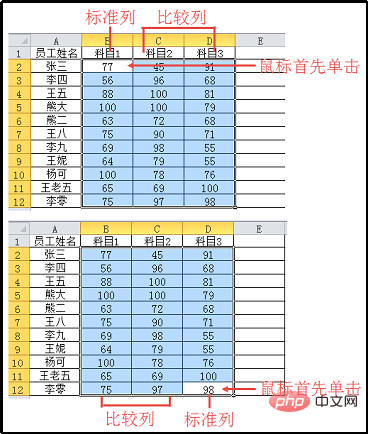
Standard rows .
The following table is the employee test score information table for three subjects. We need to quickly mark the cells that are not 100 in each subject in yellow.
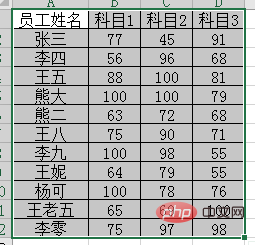 1) Quick row difference comparison ctrl shift
1) Quick row difference comparison ctrl shift

(1) Enter 100 in cell B13:D13 as an auxiliary cell , select the table data area from the bottom right to the top.
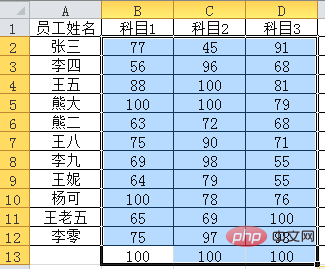 (2) Press the shortcut key ctrl shift
(2) Press the shortcut key ctrl shift

 2) Quick column difference comparison ctrl
2) Quick column difference comparison ctrl

(1) Add auxiliary data 100 in column E on the right side of the data area, from Select the data area from right to left.
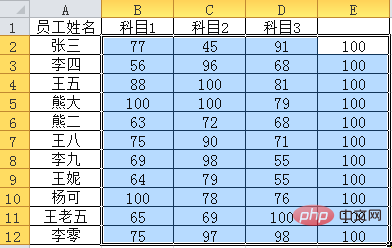 (2) Press the shortcut key ctrl
(2) Press the shortcut key ctrl

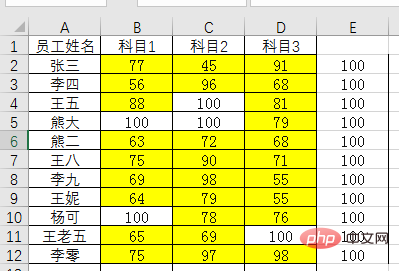 Tip 6: Quickly sort out wrong row data
Tip 6: Quickly sort out wrong row data
The data in column A in the table below shows department information and name information in alternate rows. Now we need to sort it out. Have a separate column for names and a separate column for department information.
 Operation steps:
Operation steps:
(1) First enter =A1 cell in cell B2, then select cells B1:B2 and copy and fill downwards .
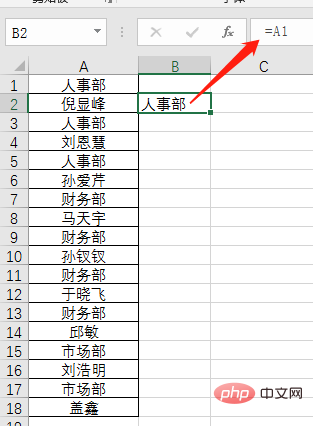
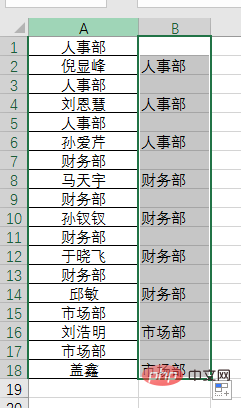 (2) Press CTRL G to open the positioning conditions and select the null value in the positioning conditions.
(2) Press CTRL G to open the positioning conditions and select the null value in the positioning conditions.
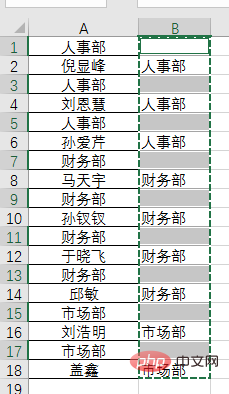
(3) Right-click the mouse and select "Delete" to delete the entire line.
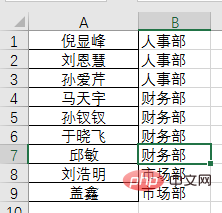
Tip 7: Batch delete objects (including charts, pictures, shapes, smartart)
We often encounter objects when using excel worksheets daily, such as Shapes, pictures, charts, smartart, etc. If you need to delete these objects at once, you can use Ctrl G. The following table is the basic information of employees, in which photos are inserted into the table as objects. We can complete the photo deletion operation through positioning.
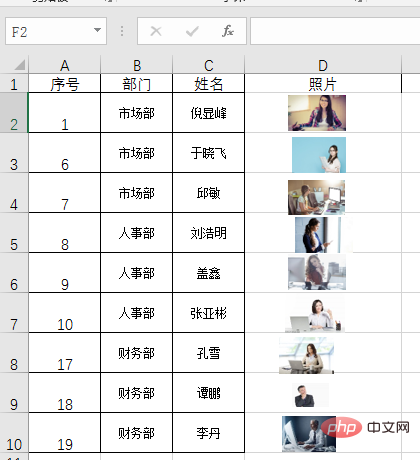
Operation steps:
(1) Use the Ctrl G shortcut key to open the [Positioning] dialog box, click [Positioning Conditions] to open the Positioning Conditions dialog box , select [Object].
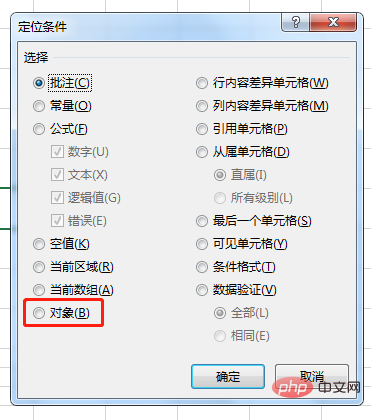
(2) After clicking [OK], we see that all the photos are selected. At this time, we only need to press delete to complete the deletion of the object photos.
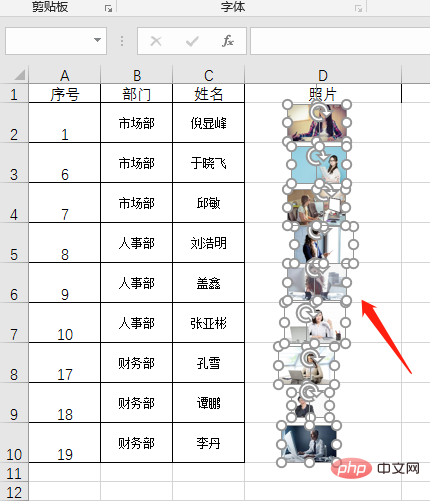
Summary
In this tutorial, we have shared 7 practical positioning skills with you. We hope that these 7 skills can help you quickly improve your work efficiency.
Related learning recommendations: excel tutorial
The above is the detailed content of Practical Excel skills sharing: 7 practical positioning skills to help you improve work efficiency. For more information, please follow other related articles on the PHP Chinese website!

Hot AI Tools

Undresser.AI Undress
AI-powered app for creating realistic nude photos

AI Clothes Remover
Online AI tool for removing clothes from photos.

Undress AI Tool
Undress images for free

Clothoff.io
AI clothes remover

AI Hentai Generator
Generate AI Hentai for free.

Hot Article

Hot Tools

Notepad++7.3.1
Easy-to-use and free code editor

SublimeText3 Chinese version
Chinese version, very easy to use

Zend Studio 13.0.1
Powerful PHP integrated development environment

Dreamweaver CS6
Visual web development tools

SublimeText3 Mac version
God-level code editing software (SublimeText3)

Hot Topics
 How to filter more than 3 keywords at the same time in excel
Mar 21, 2024 pm 03:16 PM
How to filter more than 3 keywords at the same time in excel
Mar 21, 2024 pm 03:16 PM
Excel is often used to process data in daily office work, and it is often necessary to use the "filter" function. When we choose to perform "filtering" in Excel, we can only filter up to two conditions for the same column. So, do you know how to filter more than 3 keywords at the same time in Excel? Next, let me demonstrate it to you. The first method is to gradually add the conditions to the filter. If you want to filter out three qualifying details at the same time, you first need to filter out one of them step by step. At the beginning, you can first filter out employees with the surname "Wang" based on the conditions. Then click [OK], and then check [Add current selection to filter] in the filter results. The steps are as follows. Similarly, perform filtering separately again
 What should I do if the frame line disappears when printing in Excel?
Mar 21, 2024 am 09:50 AM
What should I do if the frame line disappears when printing in Excel?
Mar 21, 2024 am 09:50 AM
If when opening a file that needs to be printed, we will find that the table frame line has disappeared for some reason in the print preview. When encountering such a situation, we must deal with it in time. If this also appears in your print file If you have questions like this, then join the editor to learn the following course: What should I do if the frame line disappears when printing a table in Excel? 1. Open a file that needs to be printed, as shown in the figure below. 2. Select all required content areas, as shown in the figure below. 3. Right-click the mouse and select the "Format Cells" option, as shown in the figure below. 4. Click the “Border” option at the top of the window, as shown in the figure below. 5. Select the thin solid line pattern in the line style on the left, as shown in the figure below. 6. Select "Outer Border"
 How to change excel table compatibility mode to normal mode
Mar 20, 2024 pm 08:01 PM
How to change excel table compatibility mode to normal mode
Mar 20, 2024 pm 08:01 PM
In our daily work and study, we copy Excel files from others, open them to add content or re-edit them, and then save them. Sometimes a compatibility check dialog box will appear, which is very troublesome. I don’t know Excel software. , can it be changed to normal mode? So below, the editor will bring you detailed steps to solve this problem, let us learn together. Finally, be sure to remember to save it. 1. Open a worksheet and display an additional compatibility mode in the name of the worksheet, as shown in the figure. 2. In this worksheet, after modifying the content and saving it, the dialog box of the compatibility checker always pops up. It is very troublesome to see this page, as shown in the figure. 3. Click the Office button, click Save As, and then
 How to type subscript in excel
Mar 20, 2024 am 11:31 AM
How to type subscript in excel
Mar 20, 2024 am 11:31 AM
eWe often use Excel to make some data tables and the like. Sometimes when entering parameter values, we need to superscript or subscript a certain number. For example, mathematical formulas are often used. So how do you type the subscript in Excel? ?Let’s take a look at the detailed steps: 1. Superscript method: 1. First, enter a3 (3 is superscript) in Excel. 2. Select the number "3", right-click and select "Format Cells". 3. Click "Superscript" and then "OK". 4. Look, the effect is like this. 2. Subscript method: 1. Similar to the superscript setting method, enter "ln310" (3 is the subscript) in the cell, select the number "3", right-click and select "Format Cells". 2. Check "Subscript" and click "OK"
 How to set superscript in excel
Mar 20, 2024 pm 04:30 PM
How to set superscript in excel
Mar 20, 2024 pm 04:30 PM
When processing data, sometimes we encounter data that contains various symbols such as multiples, temperatures, etc. Do you know how to set superscripts in Excel? When we use Excel to process data, if we do not set superscripts, it will make it more troublesome to enter a lot of our data. Today, the editor will bring you the specific setting method of excel superscript. 1. First, let us open the Microsoft Office Excel document on the desktop and select the text that needs to be modified into superscript, as shown in the figure. 2. Then, right-click and select the "Format Cells" option in the menu that appears after clicking, as shown in the figure. 3. Next, in the “Format Cells” dialog box that pops up automatically
 How to use the iif function in excel
Mar 20, 2024 pm 06:10 PM
How to use the iif function in excel
Mar 20, 2024 pm 06:10 PM
Most users use Excel to process table data. In fact, Excel also has a VBA program. Apart from experts, not many users have used this function. The iif function is often used when writing in VBA. It is actually the same as if The functions of the functions are similar. Let me introduce to you the usage of the iif function. There are iif functions in SQL statements and VBA code in Excel. The iif function is similar to the IF function in the excel worksheet. It performs true and false value judgment and returns different results based on the logically calculated true and false values. IF function usage is (condition, yes, no). IF statement and IIF function in VBA. The former IF statement is a control statement that can execute different statements according to conditions. The latter
 Where to set excel reading mode
Mar 21, 2024 am 08:40 AM
Where to set excel reading mode
Mar 21, 2024 am 08:40 AM
In the study of software, we are accustomed to using excel, not only because it is convenient, but also because it can meet a variety of formats needed in actual work, and excel is very flexible to use, and there is a mode that is convenient for reading. Today I brought For everyone: where to set the excel reading mode. 1. Turn on the computer, then open the Excel application and find the target data. 2. There are two ways to set the reading mode in Excel. The first one: In Excel, there are a large number of convenient processing methods distributed in the Excel layout. In the lower right corner of Excel, there is a shortcut to set the reading mode. Find the pattern of the cross mark and click it to enter the reading mode. There is a small three-dimensional mark on the right side of the cross mark.
 How to insert excel icons into PPT slides
Mar 26, 2024 pm 05:40 PM
How to insert excel icons into PPT slides
Mar 26, 2024 pm 05:40 PM
1. Open the PPT and turn the page to the page where you need to insert the excel icon. Click the Insert tab. 2. Click [Object]. 3. The following dialog box will pop up. 4. Click [Create from file] and click [Browse]. 5. Select the excel table to be inserted. 6. Click OK and the following page will pop up. 7. Check [Show as icon]. 8. Click OK.





